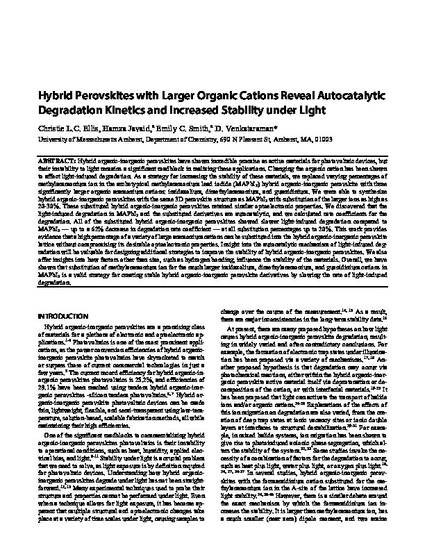
Article
Hybrid Perovskites with Larger Organic Cations Reveal Autocatalytic Degradation Kinetics and Increased Stability under Light
Inorg. Chem
(2020)
Abstract
Hybrid organic-inorganic perovskites have shown incredible promise as active materials for photovoltaic devices, but their instability to light remains a significant roadblock in realizing these applications. Changing the organic cation has been shown to affect light-induced degradation. As a strategy for increasing the stability of these materials, we replaced varying percentages of methylammonium ion in the archetypical methylammonium lead iodide (MAPbI3) hybrid organic-inorganic perovskite with three significantly larger organic ammonium cations: imidazolium, dimethylammonium, and guanidinium. We were able to synthesize hybrid organic-inorganic perovskites with the same 3D perovskite structure as MAPbI3 with substitution of the larger ions as high as 20-30%. These substituted hybrid organic-inorganic perovskites retained similar optoelectronic properties. We discovered that the light-induced degradation in MAPbI3 and the substituted derivatives are autocatalytic, and we calculated rate coefficients for the degradation. All of the substituted hybrid organic-inorganic perovskites showed slower light-induced degradation compared to MAPbI3 — up to a 62% decrease in degradation rate coefficient — at all substitution percentages up to 20%. This work provides evidence that a high percentage of a variety of large ammonium cations can be substituted into the hybrid organic-inorganic perovskite lattice without compromising its desirable optoelectronic properties. Insight into the autocatalytic mechanism of light-induced deg-radation will be valuable for designing additional strategies to improve the stability of hybrid organic-inorganic perovskites. We also offer insights into how factors other than size, such as hydrogen bonding, influence the stability of the materials. Overall, we have shown that substitution of methylammonium ion for the much larger imidazolium, dimethylammonium, and guanidinium cations in MAPbI3 is a valid strategy for creating stable hybrid organic-inorganic perovskite derivatives by slowing the rate of light-induced degradation.
Disciplines
Publication Date
2020
DOI
doi.org/10.1021/acs.inorgchem.0c01133
Citation Information
Dhandapani Venkataraman. "Hybrid Perovskites with Larger Organic Cations Reveal Autocatalytic Degradation Kinetics and Increased Stability under Light" Inorg. Chem Vol. 59 Iss. 17 (2020) p. 12176 - 12186 Available at: http://works.bepress.com/d_venkataraman/7/
